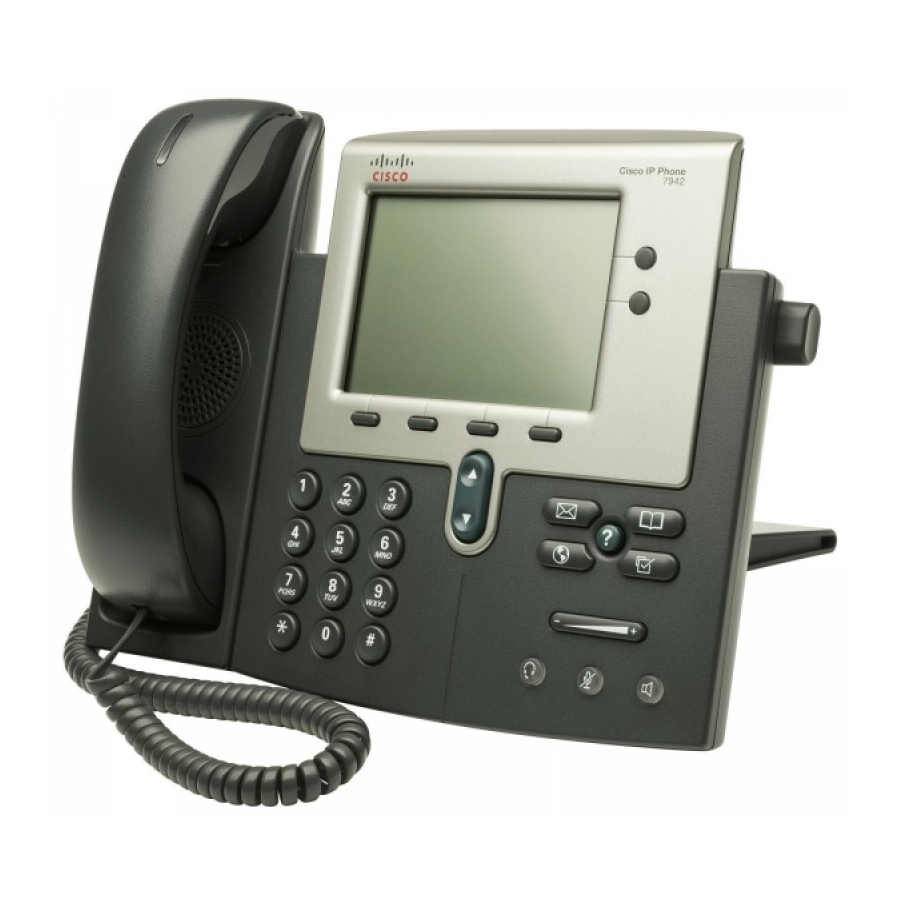
Cisco 7942 User Manual
Hide thumbs
Also See for 7942:
- User manual ,
- Quick reference manual (9 pages) ,
- User training manual (7 pages)
Advertisement
Quick Links
Download this manual
See also:
Quick Reference Manual
Programmable buttons
1
2
Phone Screen
3
Foot stand button
4
Messages button
5
Directories button
6
Help
button
7
Settings button
8
Services button
Volume button
9
10 Speaker button
11 Mute button
12 Headset button
13
Navigation button
14 Keypad
15 Softkey buttons
16 Handset light strip
Cisco IP Phone 7942 and 7962 User Guide
Depending on configuration, programmable buttons provide access to:
•
Phone lines (line buttons)
•
Speed-dial numbers (speed-dial buttons)
The buttons illuminate to indicate phone line status:
Green, steady – Active call on this line (off-hook)
Green, blinking – Call on hold on this line
Amber, steady – Privacy feature enabled (Default, All Phones have Privacy)
Amber, blinking – Incoming call ringing on this line
Red – Shared line, currently in use
○
No color – No call activity on this line (on-hook)
Shows phone features. See the "Phone Screen Features" on next page.
Allows you to adjust the angle of the phone base.
Typically auto-dials your voice message service
Opens/closes the Directories Menu. Use it to access call logs and Corporate
Directory.
Activates the Help menu.
Opens/closes the Settings menu. Use it to control phone screen contrast and ring
sounds.
Opens/closes the Services menu. Provides access to IP Phone Services
Controls the volume and other settings.
Toggles the speakerphone on or off. When the speakerphone is on, the button is lit.
Toggles the mute feature on or off. When mute is on, the button is lit.
Toggles the headset on or off. When the headset is on, the button is lit.
Allows you to scroll through menus and highlight items. Use in conjunction with
softkeys to activate highlighted items.
Allows you to dial phone numbers, enter letters, and choose menu items.
Each button activates a softkey option, displayed on your phone screen.
Indicates an incoming call or new voice message.
Pg. 1
Advertisement

Summary of Contents for Cisco 7942
- Page 1 Cisco IP Phone 7942 and 7962 User Guide Depending on configuration, programmable buttons provide access to: • Phone lines (line buttons) • Speed-dial numbers (speed-dial buttons) The buttons illuminate to indicate phone line status: Programmable buttons Green, steady – Active call on this line (off-hook) Green, blinking –...
-
Page 2: Accessing Online Help
Phone Screen Features This is what your main phone screen might look like with an active call. The following table provides a basic overview of phone screen features. Primary phone line Displays the ten digit telephone number sent for caller id. Icons indicate how programmable buttons ○... - Page 3 HANDSET, SPEAKERPHONE AND HEADSET VOLUME To increase or decrease the volume of your handset, speaker or headset during a call or after invoking dial tone, press the up or down Volume) button. The Volume button adjusts the volume for the currently active condition (handset, speaker or headset).
- Page 4 ANSWERING CALLS Lift handset, or press [Answer] softkey, [Speaker] button or [Headset] button. To answer a call when on another line, press the line of the incoming call, or press [Answer] softkey. The first call is automatically put on hold. Conditions: If you have multiple lines (shared Extension numbers) on your phone, you will need to press the other line key(s) to answer the ringing line (shared extension number).
-
Page 5: Last Number Redial
Access Personal Directory (for PAB and Fast Dial codes) Choose > Personal Directory (exact name can vary). Enter your Cisco Unified Communications Manager user ID and PIN, then press [Submit]. (Note: PSW default: 123456) Search for a PAB entry Access Personal Directory, then choose Personal Address Book. -
Page 6: Using Corporate Directory On Your Phone
To place a call, press To Use Abbreviated Dial (AbbrDial): Set up Abbreviated Dialing codes (1-99). See “Customizing Your Cisco IP Phone on the Web” user guide. To place a call, dial the abbreviated dialing code and press [AbbrDial] softkey.






